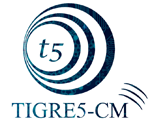The aim of the TIGRE5-CM project is to design an architecture for future generation mobile networks, based on the SDN (Software Defined Networking) paradigm, which simplifies the deployment, configuration and management of the network while integrating the latest technologies, both in the access network (reaching the end-user’s terminal) and in the core network.
Having first identified the requirements of mobile network operators (basically lower operating costs, higher performance, flexibility, resiliency and network interoperability), the TIGRE5-CM project aims to tackle these issues through a combination of the state of the art in wireless technologies with the SDN paradigm. The technical and scientific challenges to be addressed are various and multidisciplinary, and they include: wireless networks, switched and data transportation networks, and next-generation optical network technologies. In order to better meet these demands, the project team is composed of four research groups with complementary knowledge of the technologies needed to complete the project.
The objectives addressed by TIGRE5-CM are the following:
- The design of an SDN network controller, including its interfaces, for 5G networks;
- the design of mechanisms for the monitoring, supervision, and protection of the control network;
- the development of mechanisms to optimize network resource efficiency, based on traffic measurement and predictions of traffic demand;
- the development of advanced switching and transportation technologies based on generic multilayer Ethernet switches and on “all optical” transport networks with quality of service support;
- the flexibility and controllability of the user terminal by the network.
This will result in a high performance integrated architecture, with a control plane and a data plane that support a flexible, high performing network, at moderate cost, which is also configurable and programmable, robust and interoperable, and preferably built from open source hardware and software.
Upon completion, the main results of the project are expected to be:
- contributions to the state of the art with publications in top journals and conferences;
- contributions to standardization activities on new 5G network technologies at organizations such as the IEEE, the IETF, etc.
- development of testbeds that highlight the main contributions of TIGRE5-CM as well as future improvements that go beyond the project’s end date;
- collaboration with regional industrial partners to foster their leadership in 5G technologies
The research groups that are working on the TIGRE5-CM project are the WNG group from IMDEA Networks Institute, the WNL Group and the ADSCOM Group from University Carlos III of Madrid and the GIST group from the University of Alcalá.






